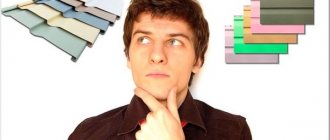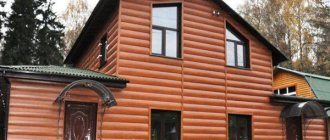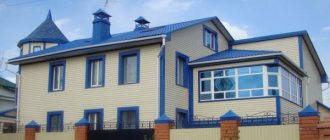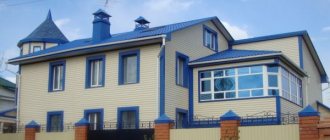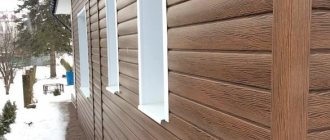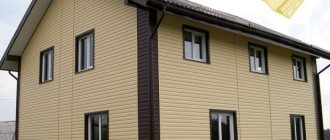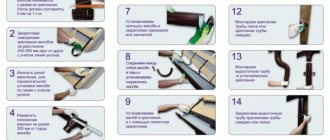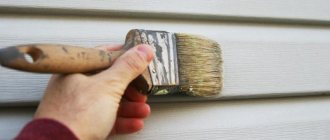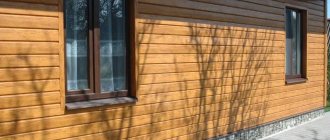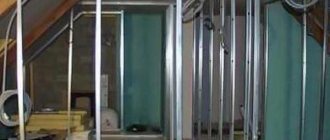Siding - (from English side - side, side surface) facing material of the outer part of the building. This cladding protects the walls from exposure to bad weather, sunlight, and adverse environmental conditions and gives the house aesthetics.
The material appeared in the nineteenth century. Initially, it was made of wood - the panels were attached to the wall at an angle so that one hung over the previous one. This protected from precipitation - moisture did not penetrate into the cracks between the boards - and the walls resisted the effects of dampness longer. However, although the destruction slowed down, it did not stop completely.
Modern siding is better protected from the elements. It can still be made from wood, but plastic (PVC) and metal varieties have become more popular. They look similar in appearance, which sometimes makes it difficult to choose. A comparison of metal and vinyl siding based on characteristics and compliance with budget and requirements will help you decide.
Characteristics of metal siding
Let's consider the technical characteristics, advantages and disadvantages of metal siding, which is most often used for exterior decoration of balconies.
Dimensions, weight, shapes
Metal siding consists of sheets with the following dimensions:
- length - up to 6000 mm (panels up to 12000 mm are available);
- thickness - on average 0.48-0.61 mm, the smallest - 0.35, the largest - 0.68 mm;
- width - different for different manufacturers, average - 120-300 mm, maximum - 550 mm;
- weight per square meter - 3-6 kg.
The thickness of the sheets depends on the underlying metal (steel, aluminum) and the outer coating. The panels can be mounted horizontally or vertically. Smooth and figured varieties are available, equipped with a large number of fittings and additional elements.
Specifications
The features of metal siding are reflected in the installation: unlike vinyl, it can be attached to the wall at almost any temperature. Metal siding retains its properties in the temperature range from -50 to +80 degrees Celsius. Warming causes a slight increase in the length of the sheets, so it is necessary to provide small gaps and avoid over-tightening the fasteners.
The material does not support combustion and is not flammable. An open fire, however, can cause deformation and burning of the outer layer, after which it will be impossible to use the sheets. Metal siding is moisture resistant and does not grow mold. Service life reaches 50 years.
Siding structure
The material is composite, consisting of several layers. They are arranged in the following order:
- polyester layer;
- chrome plated;
- zinc layer;
- cold-rolled steel sheet or aluminum/copper base;
- primer layer;
- base color layer;
- texture coating;
- polyester;
- layer of transparent protection.
The central component - metal - serves as a rigid base that takes on the load. The most common option is steel. It is coated with zinc and/or chromium to protect against oxidation and rusting due to moisture. Instead of steel, aluminum, copper, titanium, and other metals can be used. The primer improves the adhesion of subsequent polymer coatings, extending the service life of the sheets.
Coating material
The outer layers are a combination of polymer substances and protective coatings.
Polymers are necessary to provide additional protection to the metal from corrosion and the destructive effects of adverse environmental conditions. One of their main functions is to obtain the required shade and texture. The following can be used as a polymer coating:
- polyester;
- polyvinyl chloride;
- polyvinylidene fluoride;
- pural;
- acrylate
The substance is applied to the surface of the sheet in the form of powder paint. Aging in an oven increases strength, turning the powder into a protective and decorative film. A transparent varnish is sometimes applied on top of it to protect the shade from fading under the influence of ultraviolet radiation.
Advantages of metal siding
When choosing which siding is better, vinyl or metal, preference should be given to metal in the following cases:
- We need a bright façade. Metal siding resists fading longer than vinyl. It can be painted in any shade of a wide RAL palette.
- We need environmental safety. The material does not emit harmful substances and does not harm the environment or health.
- The building needs to be sheathed in winter. Metal sheets can be installed at low temperatures. They can also withstand strong heat from the sun.
- The strength of metal is required.
- The house needs to be re-clad in a short time.
- Durability required.
Metal siding is attached to a metal profile, so there is no need for a perfectly flat wall. The main thing is the absence of differences in the sheathing.
Cons of metal siding
In addition to the advantages of metal siding compared to vinyl, there are also disadvantages. These include:
- relatively considerable weight;
- large dimensions complicating transportation and installation;
- complete lack of sound insulation - raindrops, hail, dust will knock loudly when in contact with the cladding of the house;
- the need for thermal insulation - metal conducts heat too well, without protecting at all from the cold;
- under strong mechanical stress, the sheets may bend - dents will remain, which cannot be corrected without special tools and dismantling the entire coating;
- If you leave a deep scratch, corrosion processes will begin under the influence of rain and dampness.
One of the disadvantages of metal siding compared to vinyl is its high price.
Temperature effects
Touching on extreme temperature ranges, one cannot fail to note the advantages of metal siding. He is not afraid of severe frost, which causes vinyl to literally crack at the slightest blow. When overheated by the sun, there is no chance that the surface finished with metal siding will become deformed. While vinyl elements can go in waves, especially if they are installed without meeting the tolerance requirements, for which the work contractor will have to be blamed.
The need to follow strict installation rules is a negative feature of vinyl siding. It must be installed following a number of conditions. Leave allowances on the sides of each strip, do not tighten the screws all the way. Plastic contracts and expands when temperature changes. Metal siding is completely devoid of this drawback, its installation is simpler, and during operation there is no deformation due to overheating. In addition, the maximum value of the recommended temperature range for metal sheathing is 30 degrees greater than for plastic sheathing (+80 degrees Celsius versus +50).
Characteristics of vinyl siding
Let's look at the technical characteristics, advantages and disadvantages of vinyl siding.
Dimensions and shapes of siding
Like metal, vinyl siding comes in long panels in the following sizes:
- length - minimum 500 mm, maximum 3660 mm;
- thickness - 0.7-1.2 mm;
- width - 200-300 mm;
- weight per square meter - 1.7-2.3 kg.
The panels are equipped with locking connections, holes necessary for installation to the frame, and recesses for collecting sheets into a single covering. There are ventilation holes at the bottom.
For cladding facades, sheets are used in the form of:
- wooden beam (“ship plank”);
- single, double or triple herringbone;
- block house (imitation of log walls).
The surface of the material can be smooth or embossed, which allows you to achieve a complete repetition of the wood texture.
Technical characteristics of vinyl siding
If, in search of a decision on which siding to choose - metal or vinyl, the choice falls on the second type, you should remember the following material parameters:
- installation of panels is carried out at a temperature not lower than -10 degrees Celsius;
- properties are maintained in the temperature range from -50 to +50 degrees;
- under the influence of intense heat or open fire, the material melts and swells, but combustion does not occur;
- vinyl is characterized by thermal expansion - significant changes in length and width are possible with daily temperature fluctuations, so during installation it is necessary to provide gaps;
- The average service life is 20-30 years, the maximum, subject to operating conditions, is 50 years.
The parameters of this material are highly dependent on the underlying substances and coating.
Material structure
The material is produced by extrusion.
It comes in two types: monoextrusion and coextrusion. In the first case, a completely single-layer homogeneous sheet is obtained with the same color on the outside and inside. In the second case, the panel turns out to be two-layer, the heterogeneity of which is noticeable on the cut or when comparing the outer and inner sides. The co-extrusion method is more common because it reduces cost. The material consists of:
- underlying polyvinyl chloride, its mass fraction is 80-90%;
- calcium carbonate - up to 15% to fill the leaf structure;
- titanium dioxide - up to 10% to stabilize the structure and color;
- butadiene - about 1% for wear resistance;
- modifiers that impart heat resistance, impact resistance, and other properties.
The outer layer is represented by dyes.
Siding coating
All layers of vinyl siding are fused. The outer layer is often PVC with an admixture of titanium dioxide or other stabilizers necessary to give the surface the required color and protect it from washing out and fading.
When looking for a solution to which siding is better, they often single out metal or vinyl, missing out on the acrylic variety. In fact, it also belongs to vinyl, since it is based on polyvinyl chloride. However, the outside of this type is not covered with PVC with impurities, but with acrylic. The acrylic coating gives the material greater brightness and increased resistance to sunlight.
Advantages of vinyl siding
If you compare vinyl and metal siding, people will say in favor of vinyl:
- the ability of PVC panels to return to their original shape after mechanical influences - dents are straightened;
- immunity to the influence of moisture, microorganisms, harmful environmental conditions;
- light weight;
- ability to enhance sound insulation;
- low thermal conductivity;
- comparative ease of installation;
- invisible scratches;
- wide range of accessories;
- the ability to imitate wood, stone, and other materials;
- environmental Safety;
- affordable price.
When choosing PVC cladding, you should ask whether the seller has a certificate. Its presence ensures that the material will not emit acrid smoke when heated, ensuring harmlessness to health and nature.
Cons of vinyl siding
When choosing which is better, metal or vinyl siding, you need to remember the following disadvantages of the latter:
- open fire and heat exceeding +50 degrees Celsius cause melting;
- often there are only about 20 shades to choose from;
- during the production process, dyes are mixed with PVC, which has a gray color, which does not allow for maximum color brightness;
- gradually the sheets lighten or turn yellow under the influence of ultraviolet radiation;
- strong hail can break through the cladding;
- this coating cannot be painted;
- when the temperature drops below -10 degrees, the material begins to crack, especially with tightly tightened fasteners;
- in frost, fragility appears, leading to damage even with minor mechanical stress.
PVC does not conduct electricity, but sometimes vinyl siding can accumulate electrostatic charge, which can also be a disadvantage.
Advantages of facade finishing with polymers
Siding panels made of polyvinyl chloride have important operational advantages. Such sheet plastic:
- does not rot and is not subject to corrosive effects;
- does not spread flame in case of fire;
- has electrical insulating properties;
- has low weight;
- has low thermal conductivity;
- partially dampens sound and vibration vibrations;
- Available in a wide range of colors;
- easy to mount on walls;
- durable and wear-resistant.
To install the panels, parts from special profiles are used. With their help, any joints on vertical and corner joints are covered.
Disadvantages include a high coefficient of thermal expansion, the appearance of brittleness in extreme cold, and the presence of carcinogenic substances in the polymer that enter the air when heated and melted.
Comparison of metal and vinyl siding
For ease of comparison, you can combine the main characteristics of vinyl and metal siding in tabular form.
| Vinyl siding | Metal siding | |
| Strength and Durability | Sufficiently high resistance to mechanical stress - after an impact, the sheets bend back. Small scratches do not damage the entire coating and are invisible. Theoretically, if the conditions are met, the service life can reach 50 years. | Impacts cause deformation of the panels. Scratches that damage the protective layer down to the metal base lead to rust. The shelf life reaches 50 years. |
| Fire resistance | High. The material does not burn, at temperatures above 500 degrees Celsius it melts, starting from +50 degrees it softens. | High. Fire is impossible. However, at too high temperatures the sheets become deformed. |
| Environmental friendliness | With certificates, security is guaranteed. In their absence, exposure to high temperatures may release toxins. | Contains zinc. Safety must be confirmed by certificates. |
| Care | Adhering dust must be washed off frequently | Not required. Washing with water is sufficient. |
| Structure | Multilayer. The base is PVC, coated with stabilizers, modifiers, and dyes. | Multilayer. The base is metal surrounded by zinc, chrome, primer, and polymer layers. |
| Appearance | Smooth or embossed surface, mostly soft colors, the ability to imitate wood, stone, brick. | Smooth or embossed texture, fewer shapes, but more shades - the entire RAL palette. |
| Heat and sound insulation | Low thermal insulation properties are observed due to low thermal conductivity. Sounds are muffled. | High thermal conductivity, leading to a complete lack of thermal insulation. There is no soundproofing. |
| Frost and corrosion resistance | Complete resistance to water, microorganisms, mold. Poor frost resistance - when the temperature drops to -10, installation is impossible, the lower temperature limit is -50 degrees Celsius. | If there are no scratches, it is resistant to corrosion. Does not mold, is not exposed to microorganisms. There are no temperature restrictions for installation. Maintains strength down to -50 degrees Celsius. |
Distinctive features of metal and vinyl siding
When choosing which siding is better - metal or vinyl, you can take into account reviews according to which:
- inaccuracy in the sizes of panels and components in a vinyl set is completely eliminated, while in a metal set the panels are always the same, and additional elements may vary somewhat in size;
- scratches on metal siding need to be painted over with special paints to extend their service life; vinyl material does not need this;
- The color of vinyl cannot be restored, but metal can be repainted, which, however, is quite expensive;
- PVC siding panels allow you to cover rounded corners and curved walls; this is not possible for metal siding;
- To ensure that the installation of metal siding does not lead to increased heating costs, it is necessary to lay insulation under it;
- cutting metal sheets is more difficult than vinyl;
- The limited size of vinyl panels results in custom fitting, trimming required, metal siding can be custom-made to fit the size of the home, reducing waste.
Prices and cost calculation
The price of the material depends on the manufacturer, coating, color. The average price of vinyl siding ranges from 115-280 rubles, metal siding - 380-800 rubles.
The final cost is affected by:
- number of square meters;
- price and number of fasteners (for both types they cost approximately the same);
- delivery, depending on the size of the sheets (for metal siding they are longer - special transport is needed), the number of fasteners, accessories;
- complexity of installation (a block house takes longer to install - builders’ time costs more);
- availability of a warranty, its duration (the longer the better for the buyer, but the cost may be higher);
- operating costs.
Accessories
Installation of components for vinyl siding of standard sizes occurs before installation of plastic panels. There can be no exceptions.
Components for metal siding are made simple and complex. You can change the stages of the work: complex planks are installed initially, and simple ones can be attached later, since they are installed on top of the panels. Another huge advantage of metal siding is the ability to cladding non-traditional complex units on the façade of a building. The cost of components for metal is also pleasing - the difference in price with vinyl reaches 50%.
6:3 The range of components for metal is wider, plus they are cheaper.
Criteria for choosing between two types of siding
When choosing between metal or vinyl siding, in addition to reviews, you need to pay attention to:
- Number of layers. Their quantity directly affects resistance to ultraviolet radiation and precipitation. A one-layer coating is cheap, but after serving for two years it will begin to fade or peel. A three- to four-layer coating is the most durable, but also the most expensive. The compromise is a primer with a paint layer.
- Impact resistance. The coating must withstand hail, stones, impact from hard objects - leaning shovels, accidental impacts, etc.
- Fire resistance. Siding is divided into two categories: completely non-flammable NG and melting G1. The second option, when exposed to flame, releases toxic gases.
- Wind resistance. Measured in km/h. The criterion is especially important for residents of steppe regions. It is recommended to choose a material that can withstand gusts of 180-290 km/h.
- Installation location. Siding can be installed inside or outside. Only environmentally friendly material is suitable for indoor use. The outside may smell unpleasant at first.
- Invoice. It can be smooth or imitating the texture of stone, wood, brick. Affects design.
- Complete set. In addition to sheets, cladding includes J-profiles, connecting elements necessary to take into account the corners of the house, window frames, height differences, and difficult places.
- Certificates. Their presence guarantees compliance with environmental requirements, uniformity of painting, dimensional accuracy, and compliance with standards.
Siding Manufacturers
Among the manufacturers are:
The products of the German company Docke take first place in the ratings. Thanks to the popularity of the manufacturer, several of its own factories have been opened in Russia with equipment and raw materials from Germany. There are about seven thousand official sales points in the Russian Federation. The advantages of the company are a large number of siding lines, a variety of prices, textures, designs, and the ability to purchase missing material at any time. Disadvantages - when melting, corrosive gases are released, the manufacturer is more focused on vinyl, the cost is higher than average.
Dock.- Nordside. The main office of Nordside is located in St. Petersburg. Products are sold in 50 cities of Russia and CIS countries. Imported raw materials are processed using European equipment. The manufacturer carefully monitors quality, provides a 50-year guarantee, and regularly releases new models. Main lines: Lapland, Lapland log, Classic, Karelia. Disadvantages - only vinyl siding is produced, which becomes brittle in winter due to a lack of plasticizers, the lintels of the mounting slots are thin.
- Alta-Profile. The domestic manufacturer Alta-Profil produces siding in three series: Acrylic, Prestige, Alta-siding. Pros: exotic shades, easy cutting with a grinder, long-term color retention, service life up to 50 years, affordable cost. Disadvantages - overpriced accessories, small number of colors, low resistance to mechanical stress.
- U-Plast. Siding from the Belarusian manufacturer Yu-Plast is supplied to all CIS countries. The basis is European raw materials. The material is durable, resistant to temperature changes, lightweight, versatile, and can be combined with ceiling and foundation panels. Disadvantages - only vinyl products are available, the panels are difficult to cut, and there is a risk of damaging the surface when pinched.
- Grand Line. The European company Grand Line produces vinyl, acrylic, and metal siding. Pros: issuance of a written guarantee, a wide selection of textures, shapes, colors, frost resistance. Disadvantages: there are different colors in one batch, there is dust in the packaging, the shade of the window slopes rarely matches the color of the siding, and there are sheets with burrs.
Maintainability
Let's consider this case. During the period of use of the finishing material, several panels were damaged and required repair. In a situation with metal siding, replacing 1-3 panels will entail removing the entire sheathing completely. But the advantage is that such work can be carried out year-round.
Replacing one piece of vinyl siding is much easier; simply snap the panels out of the lock joint and install new ones. Repairs will not require a lot of effort, time and money. You only need a special tool. But there are also disadvantages: work on replacing plates is carried out only at above-zero temperatures, and there is also a risk of deformation of nearby panels.
1:2 the maintainability of vinyl siding is higher.
conclusions
The choice of siding type depends on the budget, size of the house, climate, and other criteria. There is no universal between the two materials. The characteristics of each vary depending on the coating, manufacturer, and operating conditions. Studying the properties of a particular type to ensure it meets your requirements will help you avoid mistakes.
In renovation, siding has found wide application for exterior decoration of balconies. A simple and affordable finishing method will transform your balcony and protect the parapet from destruction. To order finishing of a balcony with siding, contact our manager.
Advantages of siding cladding
Despite the fact that the technical characteristics of the types of facing strips made of metal and vinyl differ from each other, they are externally similar and have certain common advantages.
- Metal and vinyl cladding is suitable for creating ventilated facades with the possibility of additional insulation and waterproofing of walls.
- Modern types of siding are reliably protected from external influences.
- Metal. Metal strips include zinc and aluminum for increased ductility and anti-corrosion properties. Steel profiles are galvanized and primed, with a special protective and decorative layer; some manufacturers provide the materials with multi-layer protection on each side.
- Vinyl. It is created on the basis of a modified polymer. Special additives are added to vinyl to improve technical properties. Single-color dyeing based on the thickness of the material increases color fastness. Special decorative coatings and textures imitating timber, logs, stone or brickwork significantly improve aesthetic qualities.
